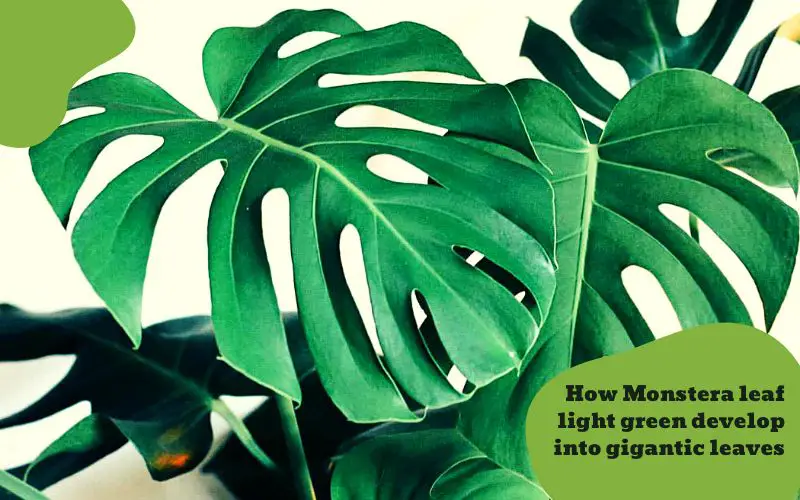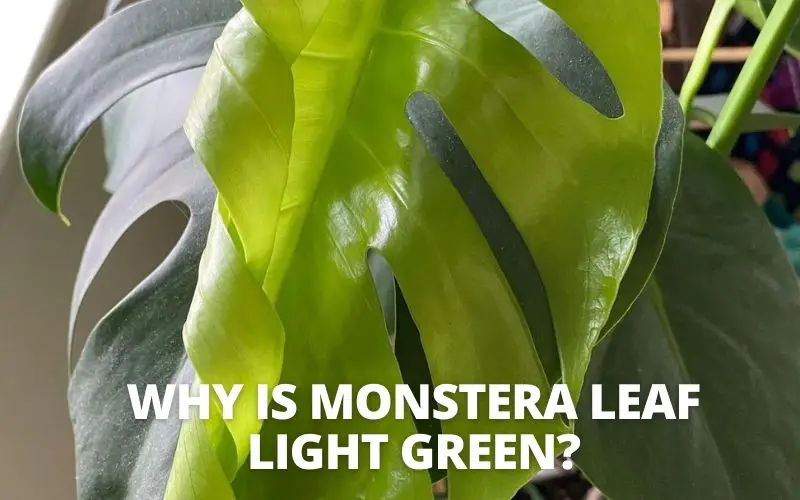Monstera Deliciosa’s new leaf is light green until they are darker and get larger. As the leaf grows more chlorophyll, it will turn a darker green tint. A shortage of light, nitrogen, or water can cause mature Monstera leaves to turn light green, which can indicate a problem. If the condition is not addressed, the Monstera leaf light green will become yellow, then brown. Find out how monstera leaves grow normally and when light green leaves become an issue in this post.
Monstera leaf’s turning light green color is a sign of growing normally
Throughout the spring and summer, Monstera plants will produce new, light green Monstera leaves on a regular basis. If you have moderate winters and water the plant consistently, they can sprout new leaves all year.

New Monstera leaves light green spikes that gradually get longer as the leaf matures. The leaf will unfold and gradually grow to its full size. Large, mature monstera leaves will acquire the classic Swiss cheese pattern, which is characterized by holes all over the leaf.
Young Monstera leaves turning light green is a sign of an early stage of development, but they do not develop holes until the plant matures and produces larger leaves. The plant must be large and mature enough to start growing the Swiss cheese leaf pattern, which takes around 2 years.
The color of the leaf will darken once it has fully unfurled or expanded up. The chlorophyll in the leaf surface begins to build up as the leaf matures, giving it a darker green color. The darker the green of the leaf, the more chlorophyll it produces. This is an indication of a healthy plant since it will have sufficient chlorophyll to convert sunlight into carbs and carbon to grow long stems and huge leaves.
Monstera leaf’s turning light green color is caused by a variety of issues
Light green Monstera leaves might sometimes indicate that there is an issue. If your plant’s adult leaves are turning light green, it’s time to take action to treat the problem and save it. Check the list below to determine if any of these issues are the cause of your Monstera leaf light green.

1. Nitrogen deficiency
Monstera leaves turn light green, then yellow and brown if there isn’t enough nitrogen in the soil. Monstera plants require nitrogen to aid in the development of green chlorophyll in their leaves. Without it, the leaves will turn a lighter green, the plant will slow down, and the leaf coverage will be reduced.
Give your plant a drink of liquid indoor plant food with a balanced nitrogen, phosphorus, and potassium ratio. This will provide a boost of nitrogen to the plant, which will aid in its recovery. To give it longer-lasting nitrogen, give it a dosage of slow-release indoor plant food two weeks later.
Monstera plants that have been in the same pot for more than two years should be repotted into fresh potting soil. To feed it for the first three months, use premium potting soil with additional slow-release fertilizer. This will provide ample nitrogen to the plant, allowing it to jumpstart its growth and heal discolored leaves.
2. Lack of sunlight
A lack of sunlight is another reason Monstera leaves light green. Plants that do not receive enough light will become tall and leggy, with lighter green stems and leaves. Monsteras require at least 6 hours of indirect sunshine to thrive. If you’re growing them outside, choose a spot that is shaded by neighboring trees or shrubs, providing protection from the sun in the afternoon.
Indoor Monstera plants should be kept far enough away from glass windows to avoid being burned, yet close enough to receive morning light. Ensure that the leaves do not receive direct sunshine, but that the plant receives filtered light throughout the day.
The leaves of the Monstera plant will grow chlorophyll and darken in color after being moved to a brighter location for 3-4 weeks. As the leaves mature, they should deepen from pale green to dark green.
3. Not enough water
If a Monstera plant isn’t getting enough water, its leaves will turn a light green color. If the plant dries out further, the leaves will turn yellow and ultimately brown. If the soil feels dry 2 inches down or if you haven’t watered your Monstera in over a month, it is most likely too dry.
Water the surface of the soil in the inner pot with drainage holes in your sink or outside. Water the plant, until the water drains out of the holes and the soil, is completely saturated. To aid in root and leaf recovery, outdoor Monstera Deliciosa can be irrigated with a seaweed solution.
Within a day, the leaves should stand up straight, and the color should return to the leaves after 2-3 weeks. With enough water, light green leaves may restore themselves.
Related Post: How long can Monstera live in water? Tips to grow them
How Monstera leaf light green develop into gigantic leaves
Before you try to get your Monstera to grow bigger leaves, keep in mind that huge leaves are a sign of a healthy, mature plant. For several years, a young Monstera with only a few light green leaves and a narrow stem will not produce growth like that. Give it some time and a lot of love.

Your Monstera needs more light
Monsteras require at least six hours of direct sunlight per day. Monsteras thrive in windows that face west, east, or south.
But, especially in flats with restricted illumination, ideal window placement isn’t always attainable. A grow light is a fantastic alternative for supplementing the available sunshine in this situation. There are many solutions available at various price ranges and in a variety of designs and styles, so anyone wishing to help their plants should think about it.
Don’t let Monstera underwatered:
If your Monstera is submerged, the leaves will usually dry out too much and droop excessively. Feel the soil in the pot to see if this is the case. It has to be watered if it’s bone dry after the first inch.
Instead, water a Monstera only after the top inch or two of soil has dried out. This happens once or twice a week for many folks. However, don’t rely on that rule. Other factors, such as the humidity level in your home and the type of pot your plant is in, might affect how quickly it dries up. You can use your finger or a little gadget called a moisture meter to check the moisture level of the soil.
Don’t let Monstera overwater
Overwatering, like any other problem with a Monstera, is far more serious than underwatering. While both are stressful for the plant, overwatering can result in fungus gnats and root rot, among other issues. Root rot is a significant problem that might kill your Monstera plant.
The moisture content of the soil is used to diagnose overwatering. Is your Monstera constantly languishing in wet, moist, or mushy soil? Have you observed that drying takes more than a week? Both of these signs point to a problem with the irrigation system, the soil, or the drainage. These problems must be addressed right now.
If you’ve recently overwatered your Monstera, allow it to dry out before watering it again. The top inch or two of soil should be dry, however, it’s a good idea to let it dry out even more if you’ve recognized you’ve overwatered it. After that, water it thoroughly and drain any surplus water only when the soil is dry to prevent the problem from getting worse.
Your Monstera Needs To Be Repotted
Monsteras require a lot of space to grow their roots in order to produce the massive leaves that make the plant so popular. A Monstera won’t be able to continue to establish roots that will support its new leaves if it isn’t in the right size container. It’s critical to report your Monstera if you want it to produce large leaves.
Monsteras should be replanted every two years in general. There is a lot of variation in this, as there is in everything. The size of the Monstera, the volume of growth, and other factors in the home can all influence how often your Monstera needs to be transplanted into a larger pot.
If you’re not sure if it’s time to repot your Monstera but it’s not generating as many large leaves as it used to, inspect the roots. There’s a chance the plant has become rooted-bound. When a Monstera runs out of room in its pot, it gets rootbound. If this is the case, the root ball will completely fill the pot, leaving very little soil in the container.
Your Monstera Needs To Be Fertilized
Another factor that may limit a Monstera’s ability to produce large leaves is the nutrition available to it. Certain nutrients, such as potassium, nitrogen, and a variety of others, are essential for plant growth. Monsteras can’t survive without them.
If you’re replanting your Monstera, you won’t have to worry about this right immediately because new soil is already enriched with the nutrients a plant requires to thrive. If your Monstera isn’t ready to be transplanted yet, the next best thing is to give it a healthy dose of diluted liquid fertilizer.
Make sure you don’t over-fertilize! Too much fertilizer can burn the roots, which can cause more harm than benefit.
Monstera light green will grow normally, especially gigantically will do their hardest to grow as long as the other prerequisites are met.
But don’t go too far with it. A Monstera’s ability to develop is harmed by being restricted to a container it has outgrown for an extended period of time, therefore if you want enormous leaves, you should fix this straight away.
When it comes to Monstera’s massive leaves, sunlight is undoubtedly the most important aspect. Giving your plant enough light will always result in poor-quality, uninspired leaves, so give it what it needs! Although each Monstera is unique, six hours of bright, indirect sunshine is an excellent starting point. If you’re not sure what that means, take a look at this article.
It explains how to acquire the correct quantity of sunlight for your Monstera.
Here’s a guide to explain why Monstera leaf turns light green, in case you’ve ever wondered. If you want to learn more about the best ways to care for this plant, keep reading DIG Nursery articles on the internet.


